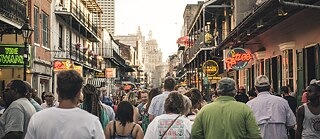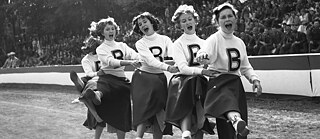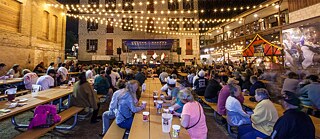Hidden Traces
Germans in New Orleans
In the streets of New Orleans, you immediately come across signs of French, Caribbean, Native American, and Spanish influences. Producer Martina Groß explores the lesser-known German history of the city.
Listen to this episode: Apple Music | Spotify | Download
This episode is by Martina Groß. Martina studied German literature, journalism, and sociology at the Free University of Berlin. Since 1997, she has been writing features for public service broadcasting in Germany. In this podcast, Martina talks to experts on German history in New Orleans. In addition to this episode, Martina produced the episode “Exploding Rents in San Francisco and in Berlin.”
Transcript
[MUSIC: FRENCH BLUES BY CAJUN ROOSTERS]
Martina Groß: New Orleans. The port on the Mississippi river has a distinct Caribbean European feel to it. Historically, the city is a cultural, spiritual, and ethnic melting pot. In the streets, you are immediately aware of French, Caribbean, Native American, or Spanish influences. Hard to imagine that there were German immigrants at one time. Rarely any guide book mentions them and there is hardly anything to be found in researching the literature. But once you know how to read the traces, the picture changes. And you will find out Germans have a long history in New Orleans.
[IN GERMAN] Aber es sind wirklich sehr viel deutsche Namen hier!
Dietmar Felber [IN GERMAN]: Ja, genau das ist es, genau das ist mir auch aufgefallen.
Martina Groß: There are many German names engraved on the mausoleums of the Cemeter Lafayette No 1.
[IN GERMAN] Das waren quasi so diese ersten Indizien, die dich ...
Dietmar Felber [IN GERMAN]: Ja, ja, im Prinzip genau.
Martina Groß: … which were the first clues of a German presence in New Orleans for Dietmar Felber — an Austrian who teaches German language at Tulane University, with whom I have an appointment at the cemetery. A necropolis with four wide avenues and countless little side streets lined with tiny houses for the dead.
Dietmar Felber [IN GERMAN]: Der John H. Felmadan. Der ist 1825 geboren ist vermutlich so um die Jahrhundertmitte nach New Orleans gekommen ...
Martina Groß: There is for example John H. Felmadan, born in 1825, who probably arrived in New Orleans in the mid-1800s and died in 1877. A cobbler. The backside of the tomb records his origin: Johann Heinrich Felmadan, who was born in Hitzerode in Hesse-Kassel.
Dietmar Felber [IN GERMAN]: ... Heinrich Felmadan, das ist derselbe Mann wie vorne.
Martina Groß: Henry?!
Dietmar Felber [IN GERMAN]: Ja, Henry.
❡
[BELLS RINGING]
Brigitta Malm: Now, you had this very early immigration, at the German Coast that was in 1720 with the company of the Indies from France. But then the main immigration was in 1850s or it was really after the German ..., you know the revolution.
[MUSIC: CENTRAL SAINT MATTHEW CHURCH]
Martina Groß: Brigitta Malm arrived in New Orleans in 1965 and she stayed. Initially, she worked for the office of the German Consulate General. Every fourth Sunday she attends the German service at Central Saint Matthew Church. She became fascinated by the heritage of German immigrants in New Orleans, especially by the history of the German Turnerverein — a traditional gymnastics club, which was represented in all major cities in the US, and was established in New Orleans in 1851. Many of the Turners were following socialist ideas. They came with the second wave of German immigration in the mid-19th century.
Brigitta Malm: The difference was that these early ones were farmers, then after the revolution the 48es were doctors, lawyers, journalists and so forth. And that really made a lot of difference, then you can tell with what has been build. There were architects. And of the exciting things for me, was, when I found out in 2001 that one of the prettiest buildings in Downtown New Orleans was actually built by a German-born architect and that’s the home for the now the Louisiana Endowment for the Humanities, it’s also called Turners Hall, it’s the Turngemeinde.
Martina Groß: The building at the corner of Lafayette and O’Keefe Street is a palazzo style building whose late classicistic style catches your eye immediately. The Turnerverein used the building as a place for physical training and cultural events.
Brigitta Malm: It was, you know, like all these organizations they came with a vague socialist idea but they formed an organization that did both: They were doing exercises and it was like a benevolent organization, they took care of widows, you know, to give them money, if the husbands died. They played theater performances and concerts in these place.
[MUSIC: GESANGSVEREIN DEUTSCHES HAUS SINGING “DIE GEDANKEN SIND FREI”]
[ORGAN MUSIC]
Martina Groß: German clubs existed in many quarters of New Orleans. In the mid-19th century, German immigrants made up 12 percent of the city’s population. Between 1818 and 1961 there were more than 50 German churches, congregations and synagogues in the city. At one point in time, more than 70 magazines and journals were published in German. Most of them, however, were short-lived. Only two survived the 19th century. European politics cast their shadow all the way over the big pond. The wars between France and Germany in the 19th century, both World Wars in the 20th century. The Great War led to a temporary ban of German publications and teaching the German language in schools was forbidden. But many German immigrants had started anglicizing their names long before, like Heinrich Felmadan, or the Zweig family translating their name to the French La Branche. Being German was not always en vogue.
Brigitta Malm: ... and then all these organizations or the choir, Liederkranz and so forth, lost members because of Word War I. And that’s when the idea of the Deutsches Haus came up and they all met and formed this one club.
❡
[STREET NOISE]
Martina Groß: Just a few minutes walking from Canal Street’s end of the streetcar station at Park City is the Deutsche Haus — The German House! A modern, new building made of grey stone with a high elongated gabled roof. It opened its doors to the public at the end of November 2018, just in time for the 90th anniversary of the club. I have an appointment with Denise Barnett in the large storage space next door.
Denise Barnett: Ah! The Berlin Bär. It was given to the city of New Orleans before 1992. The port of New Orleans got, I think we got a newspaper clipping that talks about when it was originally given to the city New Orleans and the port in New Orleans had him in their building. And in August of 1992 they gave it to us, to house and to take care of, so ...
Martina Groß: Oh, it’s really heavy!
Denise Barnett: Yeah, oh yeah.
Martina Groß: The best place for the guest from Berlin still needs to be found in the house. Just like almost everything else on the shelves, pallets and tables, the bear belongs to the inventory of the old Deutsche Haus. In 2011, the historic building had to make place for a new hospital in the city of New Orleans. It turned out to be rather difficult to agree on a design concept that pleased everyone for the new Deutsche Haus, and combining the new with the traditional. It definitely was not to be in Bavarian half-timbered style. But what kind of German identity was it supposed to reflect? Not an easy task as Jack Gonzales, the chair of the Deutsche Haus reports:
Jack Gonzales: We wanted to be able to open our doors and offer the experience to anyone who’d like to come. And so a lot of times they are in conflict a little like, you know, you are displeasure, we could have more of different things to represent your region or your area. And we want to do that more. And really, the challenge that we’ve gotten from all the different members of German decent it’s such a different opinion on what it all means. And we struggle every day, to try to make sure that everybody has a good feeling of Gemütlichkeit. Yeah.
Martina Groß: Obviously proud of the new generously laid out building, Jack Gonzales points out the two bars with the porcelain beer taps. There is a choice of several distinct craft beers. Wooden beams from the old Deutsche Haus were recycled for building the counter. Biersteins are kept in illuminated lockers, which members can rent for a monthly fee. This is the place where female and male choirs rehearse and German courses are taught.
Jack Gonzales: ... like a Kino night, where we show German films. Most are in subtitles and then of course, not only just do we show films, but we do comedic shows, we do bands, like we did Rammstein a while ago, you know, but had a group of people that came and it was a successful evening.
Martina Groß: Sustenance is provided seven days a week. Brats and sauerkraut, schnitzel and other tasty German comfort food are on offer. The heart of the building is the festival hall, or beer hall. And of course, there is a big Oktoberfest every year – a chance to buy souvenirs without having to travel to Germany.
Keith Oldendorf: Of course we have Biersteins, what, what German festival wouldn’t be ... German festival wouldn’t be complete without Bierstein. So we actually get these from an importer.
Martina Groß: The choice is overwhelming!
Oh, these German 3D realistic lederhosen. Wow! [OLDENDORF LAUGHS] Where do you get these things from?
Keith Oldendorf is in charge of purchasing.
Keith Oldendorf: Ah, it’s, yeah kind of search a lot. It’s not easy to find.
Martina Groß: Associations like the Deutsche Haus, their objectives and perhaps even the self-conception of their members are changing. Many younger people are signing up for membership. Thanks to them, a less traditional image of Germany is on the rise.
Keith Oldendorf: We are trying to become a little bit more modern. We are trying to get away from some of the older things ... while traditional! And we are not gonna ... we won’t forget them. We also want to represent Germany today.
❡
[MUSIC: GERMAN-AMERICAN CULTURAL CENTER CHOIR SINGING]
Martina Groß: On the other side of the Mississippi, in Gretna, the German-American Cultural Center is in charge of keeping tabs on the history of German immigrants. This is where I meet its assistant director Ira Hopkins:
Ira Hopkins: You see Gretna was founded by Germans. And it was originally called Mechanicham. And it was called Mechanicham, because the owner of the plantation, the Desperham Plantation that was here, brought over some Germans and they came from the New Orleans area, ‘cause this was a big port of embarkation. And they were real handy with their hands. They build the sprockets, the puli’s, the levees, in effect, they were the mechanics. This is why this area was called Mechanicham, because they settled here.
Martina Groß: The Cultural Center portrays German immigration from the early 18th century to now. The former school exhibits everything that the immigrants thought was worth taking with them to the New World: hand-made embroidery, clothing, kitchen utensils, photographs and yes, their language. You can listen to recordings of German choirs. There are posters for German theater or ballet productions or of those politicians, architects and business people of German heritage who have shaped and contributed to the life and culture of New Orleans for decades. Should you be thus inclined, this is where you can research your family history. Or visit the Lafayette Cemetery to find the traces of the melting pot that New Orleans is still today.
Dietmar Felber [IN GERMAN]: Hier ist ein deutscher Name nach dem anderen.
Martina Groß [IN GERMAN]: Ah, aber Leidenheimer ist doch auch ... Das habe ich doch gestern gehört!
Leidenheimer’s bakery still bakes bread, but today it is French.
Dietmar Felber [IN GERMAN]: Ja, das kann sein, es gibt eine Bäckerei, die heißt so in New Orleans.
Martina Groß [IN GERMAN]: ... die heißt immer noch so?!
Though, today the bread is French.
Dietmar Felber [IN GERMAN]: Leidenheimer Bakery. Die macht French Bread.
[LAUGHING]
[MUSIC: FRENCH BLUES BCAJUN ROOSTERS]







